Aircraft Electrification Market Overview, 2032
The global aircraft electrification market was valued at $6.2 billion in 2022, and is projected to reach $21.8 billion by 2032, growing at a CAGR of 13.5% from 2023 to 2032.Aircraft electrification is the process of powering aircraft systems through electrical means rather than through traditional fuel-based methods. The process offers a number of potential benefits including increased fuel efficiency, reduced emissions, and increased aircraft range. The aircraft electrification market is currently in a growing phase. The market includes the development, manufacturing, and supply of various components and systems used in aircraft electrification. The aim of electrification in aircraft is to make air travel sustainable and environment-friendly while also improving performance and reducing costs.
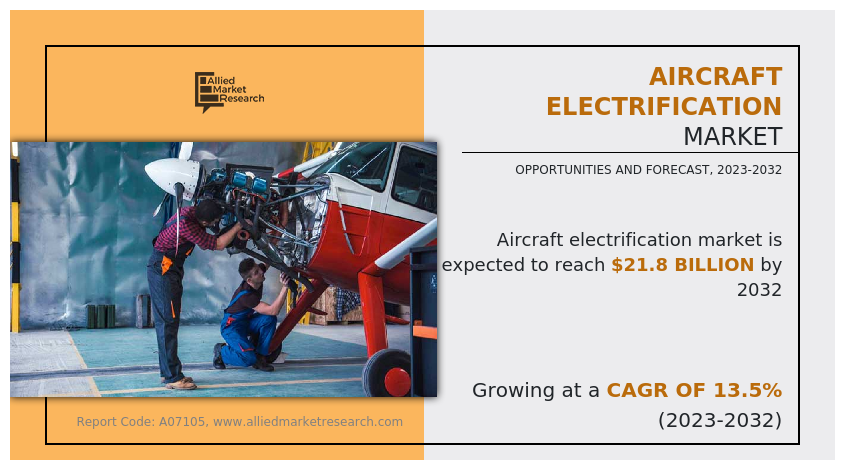
The aircraft electrification market is driven by factors such as an increase in the need for cleaner and quieter aircraft, a rise in demand for electrical components in aircraft, and advancement in electric aircraft propulsion systems. However, high voltage and thermal issues of aircraft electrical systems and high capital requirements hamper the market growth. Moreover, the expansion of alternative power sources and the development of lithium-ion batteries create lucrative growth opportunities for the market.
In addition, the airline industry is under increasing pressure to reduce its carbon footprint. Electric propulsion systems and energy storage systems in aircraft electrification are potential technologies that might help the aviation industry reduce pollution. Moreover, electric aircraft is currently being developed by several aircraft manufacturers. To create a hybrid electric regional airline, for instance, Airbus has teamed up with Rosales and Siemens. The company anticipates that the airline will begin operations in 2030.
The aircraft electrification market is segmented on the basis of components, technology, application, and region. By component, the market is divided into batteries, fuel cells, electric actuators, generators, motors, power electronics, distribution devices, and others. By technology, the market is classified into more electric, hybrid electric, and fully electric. By application, the market is categorized into power generation, power distribution, power conversion, and energy storage. By region, the market is analyzed across North America, Europe, Asia-Pacific, and Latin America, Middle East & Africa (LAMEA) including country-level analysis for each region.
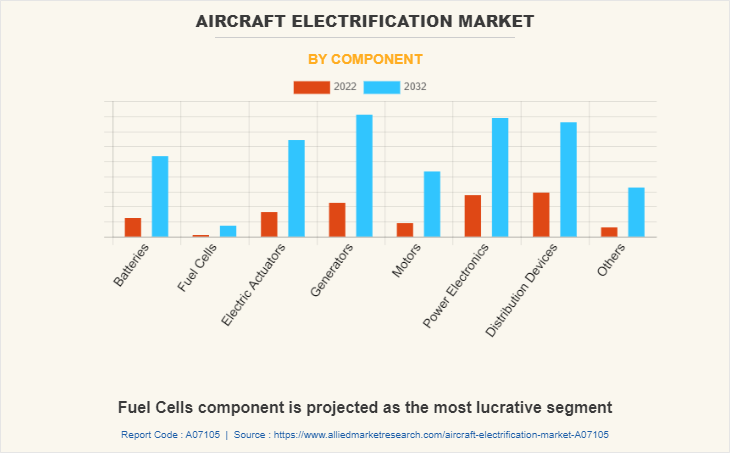
North America comprises U.S., Canada, and Mexico. The aviation industry is under increasing pressure to reduce carbon emissions, and electrification is seen as one of the key solutions to achieving this goal. The increasing demand for electric and hybrid-electric aircraft is driving the growth of the market in the region. In addition, North America is home to several major aircraft manufacturers, including Boeing, Lockheed Corporation, and others, which are investing heavily in electric and hybrid-electric aircraft technology propelling the aircraft electrification market share in the fully electric segment.
Government agencies have been working on the development of fuel-efficient aircraft and advanced aircraft technologies. U.S. commercial, government, and defense organizations have increased the adoption of more electric aircraft technologies to enhance aircraft capabilities. Similarly, The Canadian government has set a goal to reduce greenhouse gas emissions to net zero by 2050, which is driving the adoption of electric and hybrid-electric aircraft in the region.
Competitive analysis and profiles of the major aircraft electrification market players include Ametek, Astronics Corporation, BAE Systems plc., Honeywell International Inc., Magnix, Meggitt PLC, Collins Aerospace, Rolls Royce Plc, Safran, and Thales Group. The leading companies are adopting strategies such as acquisition, agreement, expansion, partnership, contracts, and product launches to strengthen their market position. In September 2022, Thales Group & amp Safran entered into negotiations to acquire its aeronautical electrical systems business. The proposed acquisition includes Thales Avionics Electrical Systems and Thales Avionics Electrical Motors companies in France, as well as the support, maintenance & production activities for aeronautical electrical equipment in Orlando (USA) and Singapore.
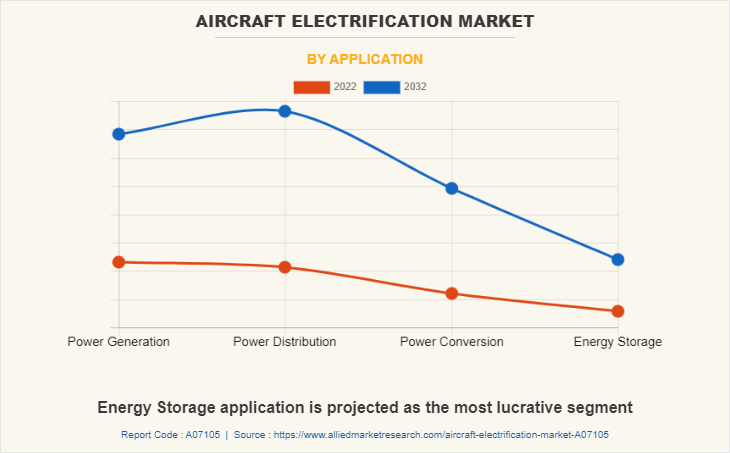
In July 2022, Safran S.A. developed a pioneering electric nose wheel steering and extension/retraction system for tomorrow’s narrowbody and widebody commercial jets & Unveils Electric Nose Landing Gear Actuator. The new electro-hydrostatic actuators (EHA) drive these functions using hydraulic power generated locally at the front of the aircraft by an electric motor pump. In August 2021, Astronics Corporation signed an agreement with Aerotec Concept of Toulouse, France providing both companies the opportunity to offer a greater breadth of new technologies, applications, and/or modifications requiring EASA (European Union Aviation Safety Agency) and FAA (U.S. Federal Aviation Administration) certifications to the marketplace. In July 2021, Rolls-Royce plc developed and started testing the most powerful hybrid-electric propulsion system in aerospace. The tests are part of the 2.5-megawatt (MW) Power Generation System 1 (PGS1) demonstrator programmed, for future regional aircraft. In July 2020, Collins Aerospace & Hybrid Air Vehicles first developed a working prototype of a 500-kilowatt electric motor suitable for the Airlander 10aircraft. Airlander 10 is scheduled to begin hybrid-electric operation in 2026, followed by an all-electric, zero-emission operation in 2030. In July 2019, Astronics Corporation acquired Freedom Communication Technologies, a provider of advanced communication systems for the aviation, defense, and public safety markets. The acquisition intended to expand Astronics' capabilities in wireless communication technologies, including those used in aircraft electrification.
Increasing need for cleaner and quieter aircraft
The aviation industry is increasingly recognizing the importance of reducing environmental impact, particularly in terms of carbon emissions and noise pollution. As a result, there is a growing need for aircraft that are cleaner and quieter, which has led to a shift toward aircraft electrification & other innovative technologies that can achieve these goals. In addition, governments around the world are introducing environmental regulations that place stricter limits on aircraft emissions and noise levels. Furthermore, electrification is expected to reduce operating costs and increase efficiency. Electric motors are much more efficient than combustion engines, which means that electric aircraft can use less energy to fly the same distance.
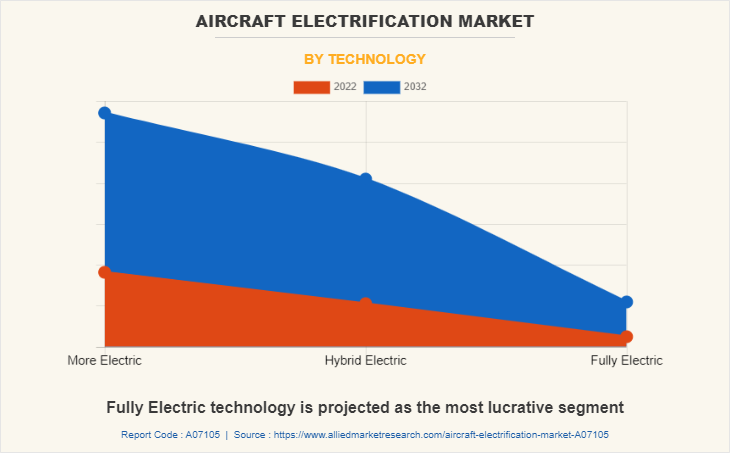
Advancement in electric aircraft propulsion systems
The development of electric aircraft propulsion systems is gaining momentum due to the surge in the need for sustainable and eco-friendly aviation. The aviation industry is one of the major contributors to greenhouse gas emissions, and the use of fossil fuels in aviation is a major source of carbon emissions. Electric propulsion systems offer a promising alternative to traditional fossil fuel-powered aircraft, as they produce zero emissions and are highly efficient. Another area of development in electric aircraft propulsion is the use of superconducting motors. Superconducting motors use superconducting materials to achieve higher power densities and efficiencies than traditional motors. The development of electric aircraft propulsion systems is an exciting and rapidly evolving field that holds great promise for the future of aviation. The emergence of eVTOL aircraft, superconducting motors, and other electric propulsion technologies is paving the way for a sustainable and environment-friendly aviation industry.
High voltage and thermal issues of aircraft electrical systems
The risk of high voltage and thermal issues becomes significant as the use of electrical systems in aircraft continues to increase. High voltage is a significant concern in aircraft electrical systems, as it can cause electrical arcing, insulation breakdown, and damage to electrical components. High voltage can also lead to electrical shock hazards for maintenance personnel. For instance, the Boeing 777 aircraft experienced an electrical failure caused by a high-voltage arc in the aircraft's electrical system. The arc occurred due to a fault in a power panel, which caused the panel to short-circuit and emit a high-voltage arc. The incident led to the grounding of several 777 aircraft until the issue was resolved. Aircraft electrical systems frequently use high dielectric strength insulating materials like silicone rubber or polyimide as well as forced air cooling, liquid cooling, or thermal management materials to dissipate heat from electrical components to manage high voltage and temperature difficulties.
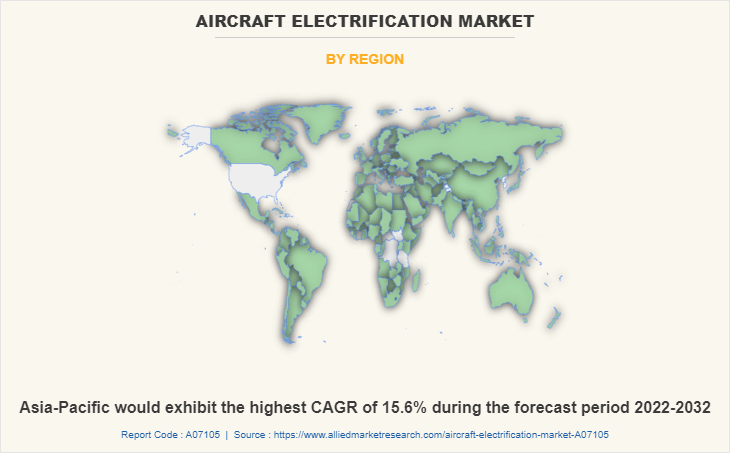
Expansion of alternative power sources
Alternating current (AC) generators are a secondary power source that can supply the electrical energy required by the avionics equipment on an aircraft. Modern generators supply power to aircraft loads using alternative power sources like hydrogen cells, biofuel, and other power sources to preserve the safe operation of aircraft and the comfort of the passengers. For instance, in March 2021, Honeywell announced the development of a 1-Megawatt generator power source that runs on aviation biofuel such as Honeywell Green Jet Fuel. The generator can be used to run high-power electric motors in drones, air taxis, and commuter aircraft, or to charge batteries. The equipment on board the aircraft is also powered by these electrical generators that use alternate power sources.
Key Benefits For Stakeholders
- This report provides a quantitative analysis of the market segments, current trends, estimations, and dynamics of the aircraft electrification market analysis from 2022 to 2032 to identify the prevailing aircraft electrification market opportunities.
- The market research is offered along with information related to key drivers, restraints, and opportunities.
- Porter's five forces analysis highlights the potency of buyers and suppliers to enable stakeholders make profit-oriented business decisions and strengthen their supplier-buyer network.
- In-depth analysis of the aircraft electrification market segmentation assists to determine the prevailing market opportunities.
- Major countries in each region are mapped according to their revenue contribution to the global market.
- Market player positioning facilitates benchmarking and provides a clear understanding of the present position of the market players.
- The report includes the analysis of the regional as well as global aircraft electrification market size, trends, key players, market segments, application areas, and market growth strategies.
Aircraft Electrification Market Report Highlights
| Aspects | Details |
| Market Size By 2032 | USD 21.8 billion |
| Growth Rate | CAGR of 13.5% |
| Forecast period | 2022 - 2032 |
| Report Pages | 270 |
| By Component |
|
| By Application |
|
| By Technology |
|
| By Region |
|
| Key Market Players | Safran S.A., BAE Systems, MagniX, Astronics Corporation, Rolls-Royce plc, Collins Aerospace, Ametek.Inc., Thales Group, Honeywell International Inc., Meggitt plc |
Analyst Review
The aircraft electrification market is projected to witness a high growth rate, owing to the rise in awareness related to the need for a reduction in carbon emissions generated from the aviation industry. Aircraft electrification reduces harmful emissions and offers users a lesser operational cost.
Experts also predict that the aircraft electrification market is an exciting and rapidly evolving sector, with significant potential for growth and innovation in the coming year. For instance, Ray Conner, former CEO of Boeing Commercial Airplanes, stated that he believes electric aircraft will become a reality sooner than many people expect. He cited the rapid advances in battery technology and the increasing demand for sustainable aviation as factors driving the development of electric aircraft.
Similarly, Tom Enders, former CEO of Airbus, has stated that he believes electric and hybrid-electric aircraft will play a significant role in the future of aviation and that Airbus is committed to leading the industry in this area. Airbus has already developed several electric aircraft prototypes, including the E-Fan and the CityAirbus.
The key factors that drive the growth of the market are the surge in demand for electric aircraft propulsion systems, the emergence of electric-powered aircraft, the surge in initiatives to reduce environmental emissions through aircraft and strict regulations concerning carbon emissions by aircraft. However, the development of electric aircraft faces several challenges, such as the weight and size of batteries, limited range and endurance of electric power systems, and the need for significant advances in battery technology hamper the market growth during the forecast period.
Among the analyzed regions, Europe is expected to account for the highest revenue in the global market throughout the forecast period, followed by North America, Asia-Pacific, and LAMEA. Moreover, Asia-Pacific is expected to witness the highest growth rate owing to growing air traffic in the region driving the demand for modernization and enhancement of existing aircraft infrastructure.
Further, the market is consolidated by the presence of major key players such as Ametek, Astronics Corporation, BAE Systems plc., Honeywell International Inc., Magnix, Meggitt PLC, Collins Aerospace, Rolls Royce Plc, Safran, and Thales Group. These players have adopted efficient techniques to develop innovative products.
The global aircraft electrification market was valued at $6.2 billion in 2022, and is projected to reach $21.8 billion by 2032.
Ametek, Astronics Corporation, BAE Systems plc., Honeywell International Inc., Magnix, Meggitt PLC, Raytheon Technologies/Collins Aerospace, Rolls Royce Plc, Safran, and Thales Group.
In the aircraft electrification market, the leading application is power generation.
The largest regional market for aircraft electrification is Europe.
Increasing need for cleaner and quieter aircraft, advancement in electric aircraft propulsion systems and expansion of alternative power sources are anticipated to drive the growth of the global aircraft electrification market during the forecast period.
Loading Table Of Content...
Loading Research Methodology...


